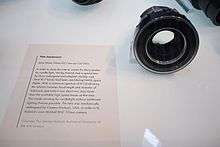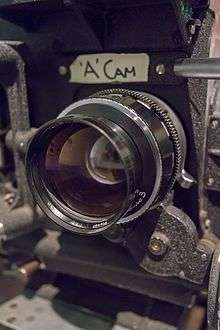Carl Zeiss Planar 50mm f/0.7

Lens on display during the Stanley Kubrick exhibition.

Lens attached to camera as used for Barry Lyndon
Carl Zeiss Planar 50mm f/0.7 is one of the largest aperture lenses in the history of photography.[1] The lens was designed and made specifically for the NASA Apollo lunar program to capture the far side of the moon in 1966.[2][3]
Stanley Kubrick used these lenses when shooting his film Barry Lyndon, which allowed him to shoot scenes lit only by candlelight.[4][5]
In total there were only 10 lenses made. One was kept by Carl Zeiss, six were sold to NASA, and three were sold to Stanley Kubrick.[1]
References
- 1 2 World's fastest lens: Zeiss 50mm f/0.7
- ↑ Hollywood, NASA, and the chip industry put their trust in Carl Zeiss
- ↑ Dr. J. Kämmerer «When is it advisable to improve the quality of camera lenses?» Excerpt from a lecture given during the Optics & Photography Symposium, Les Baux, 1979
- ↑ Ed DiGiulio «Two Special Lenses for Barry Lyndon» American Cinematographer How the stringent demands of a purist-perfectionist film-maker led to the development of two valuable new cinematographic tools.
- ↑ This Month's Object: the Zeiss lens f/0.7 Archived February 11, 2012, at the Wayback Machine.
External links
- History of fast 35mm and small format film lenses
- Photo of the lens
- A schematic view of the optical design of the lens
- (Italian) OMAGGIO ALL'IMMORTALE KUBRICK ED AL MITICO PLANAR 50mm f/0,7
- (German) Frühe lichtstarke Objektive für 35mm und andere Kleinbildformate
- (French) # sk Objectifs ultra-lumineux
This article is issued from Wikipedia - version of the 11/19/2016. The text is available under the Creative Commons Attribution/Share Alike but additional terms may apply for the media files.